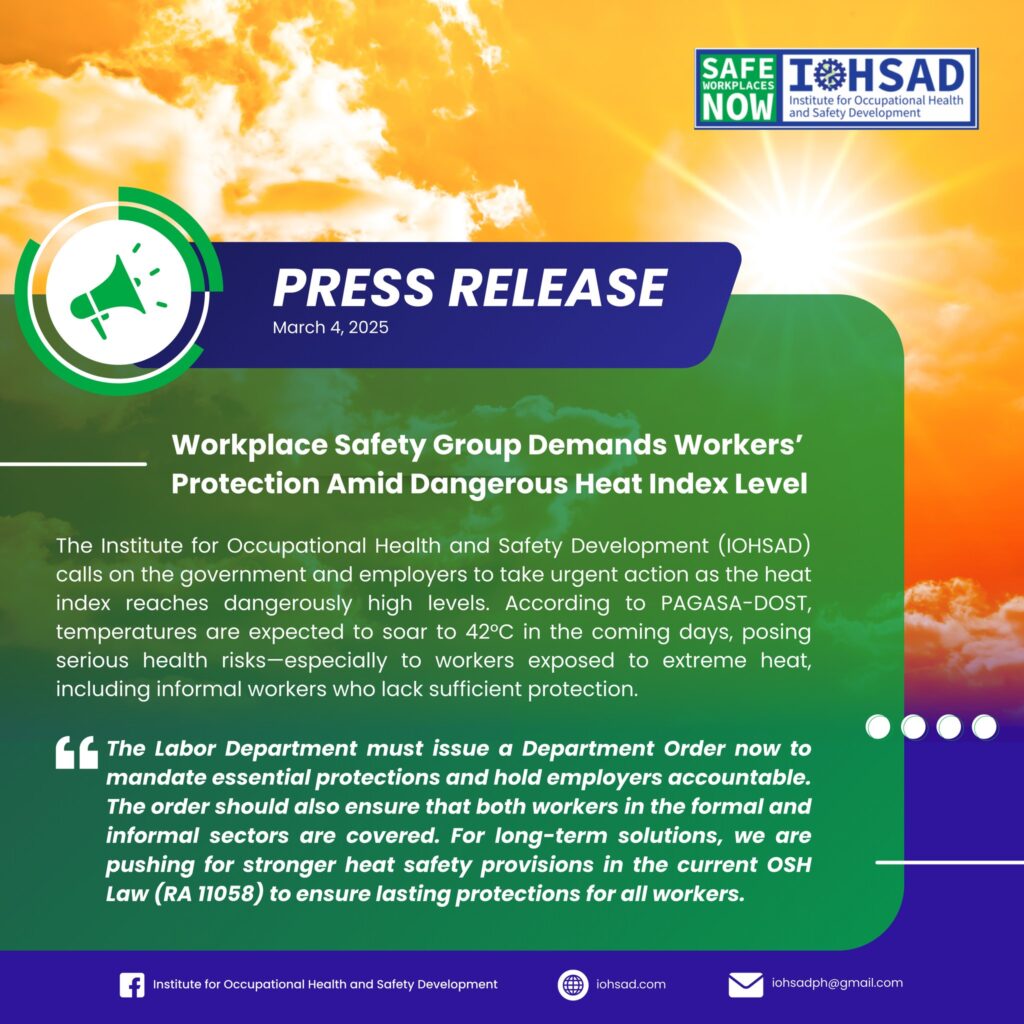𝘏𝘦𝘢𝘵 𝘚𝘢𝘧𝘦𝘵𝘺 𝘕𝘰𝘸! Workplace Safety Group Demands Workers’ Protection Amid Dangerous Heat Index Level

The Institute for Occupational Health and Safety Development (IOHSAD) calls on the government and employers to take urgent action as the heat index reaches dangerously high levels. According to PAGASA-DOST, temperatures are expected to soar to 42°C in the coming days, posing serious health risks—especially to workers exposed to extreme heat, including informal workers who lack sufficient protection.
Air temperature alone does not fully reflect how hot conditions feel. The heat index, which accounts for both air temperature and humidity, provides a more accurate measure of perceived temperature. Based on PAGASA-DOST’s heat index chart, the forecasted levels fall within the danger zone, significantly increasing the risk of heat stress and related illnesses.
Moreover, Dr. Thomas H. Gassert, an Instructor in Occupational and Environmental Medicine at Harvard T.H. Chan School of Public Health, states that heat stress in the workplace can lead to heat-related illnesses (HRI), which begin to manifest when the body’s core temperature reaches 38.0°C or higher. Symptoms can quickly develop, including dehydration, skin rash, muscle cramps, fainting (syncope), and heat exhaustion, often accompanied by profuse sweating, nausea, headache, and weakness.
In the Philippines, factors such as poor workplace ventilation, physically demanding tasks, and pre-existing medical conditions further increase workers’ vulnerability to heat stress. With temperatures rising rapidly, implementing urgent protective measures is crucial to safeguarding workers’ health and well-being.
To help prevent heat-related illnesses and ensure workers’ health and safety, IOHSAD demands the immediate implementation of the following measures:
1. 𝗛eat breaks that are paid and compensable during peak temperature hours
2. 𝗘ducation on heat stress prevention through mandatory workplace training
3. 𝗔djusted work hours to avoid the hottest periods of the day
4. 𝗔ssessment of health conditions and medical check-ups for workers
5. 𝗧emperature-appropriate and free personal protective equipment (PPE)
6. 𝗦haded and accessible rest areas for workers, especially those who are working outdoors.
“We are already seeing dangerously high temperatures this March, and they will continue to rise in the coming days. Yet, all we have so far is a non-binding advisory from the Labor Department. This is a weak reminder to employers that does nothing to hold them accountable,” said Nadia De Leon, IOHSAD Executive Director.
“Workers cannot wait. In this extreme heat, every delay puts lives at risk. We demand immediate government action. The Labor Department must issue a Department Order now to mandate essential protections and hold employers accountable. The order should also ensure that both workers in the formal and informal sectors are covered. For long-term solutions, we are pushing for stronger heat safety provisions in the current OSH Law (RA 11058) to ensure lasting protections for all workers,” De Leon added.
IOHSAD remains committed to ensuring workers’ safety as temperatures rise. The government and employers must act swiftly to prevent heat-related illnesses and uphold workers’ right to a safe and healthy workplace. No worker should have to risk their health for their livelihood.
To amplify workers’ voices, IOHSAD has launched the “Bantay Init Sa Trabaho” campaign, encouraging workers to share their experiences of working in extreme heat. Using the hashtag #TrabaHOTiis, workers can share their stories, which will be collected and used to strengthen our call for the government to immediately issue a Department Order ensuring urgent and enforceable protections for workers facing dangerous heat conditions.
